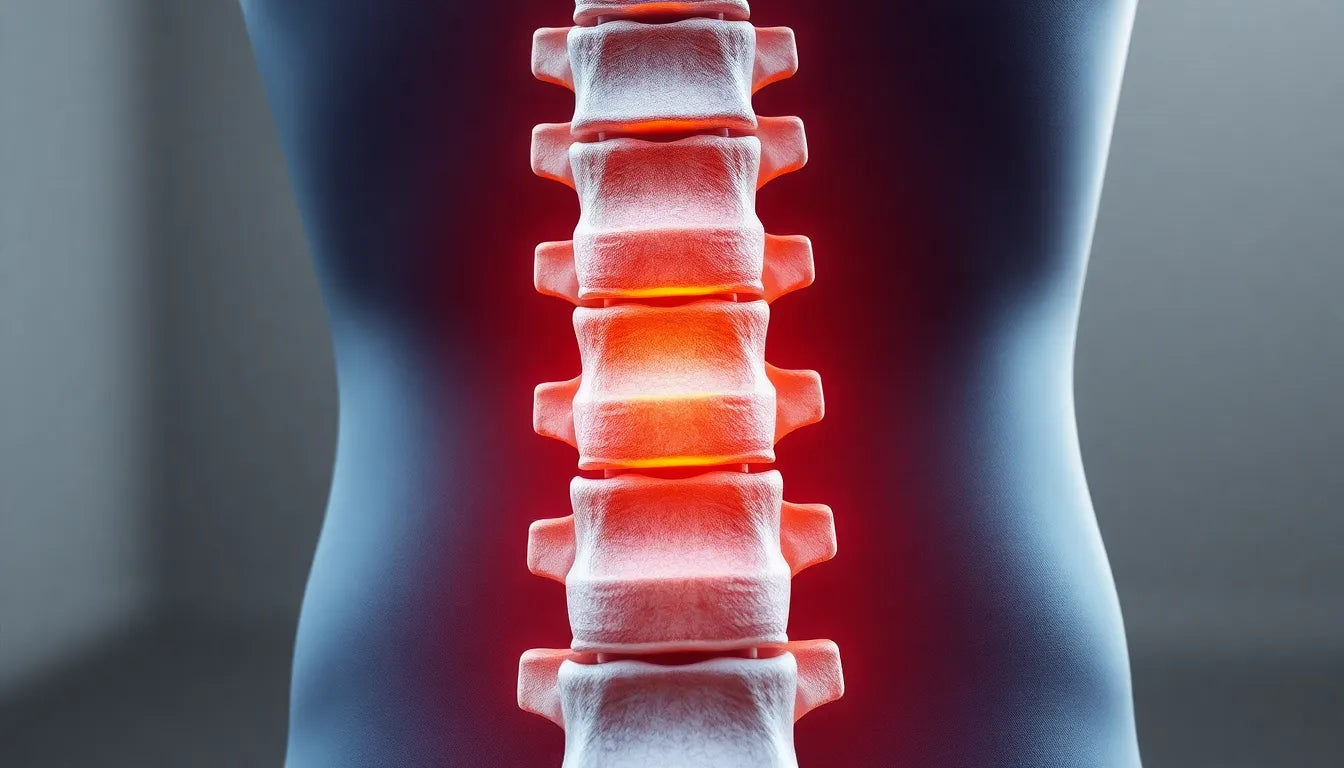Spondylosis is a term that might not be familiar to everyone, yet it represents a condition affecting a significant portion of the population, particularly as they age. This condition, often misunderstood, involves the spine and can have a considerable impact on one's quality of life. As people age, the wear and tear on their bodies become more pronounced, and spondylosis is a prime example of this natural progression. Its prevalence is especially notable among older adults, making it an important topic for those seeking to maintain their health and mobility in later years.
Understanding spondylosis
At its core, spondylosis refers to the age-related degeneration or wear and tear of the spinal vertebrae and discs. It is synonymous with spinal osteoarthritis, a condition that arises as the cushioning discs between the vertebrae begin to break down over time. This degeneration can lead to a variety of symptoms, ranging from mild discomfort to severe pain and mobility issues. The cervical (neck) and lumbar (lower back) regions are the most commonly affected areas, although spondylosis can occur anywhere along the spine.
The development of spondylosis is a natural part of aging, much like the graying of hair or the development of wrinkles. However, unlike these cosmetic changes, spondylosis can have a profound effect on one's physical well-being. As the spinal structures deteriorate, they can lead to stiffness, pain, and even nerve compression, which may result in more serious neurological symptoms. Understanding this condition is crucial for managing its impact and maintaining a good quality of life.
The importance of early recognition
Recognizing the signs of spondylosis early is essential for effective management and to prevent further progression. Early intervention can significantly reduce the severity of symptoms and improve overall outcomes. By identifying spondylosis in its initial stages, individuals can take proactive steps to manage their condition through lifestyle adjustments, physical therapy, and other non-invasive treatments. This proactive approach not only helps in alleviating pain but also in maintaining flexibility and mobility.
In conclusion, spondylosis is a common condition that affects many individuals, particularly as they age. Understanding what spondylosis is and recognizing its early signs are vital steps in managing its effects. By doing so, individuals can take control of their health, reduce the impact of this condition, and continue to lead active, fulfilling lives. As we delve deeper into the causes, symptoms, and treatment options in the following sections, it becomes clear that knowledge and early action are powerful tools in navigating the path to pain relief and improved spinal health.
Causes and risk factors of spondylosis
Spondylosis is primarily an age-related condition, but several factors can accelerate its progression or increase the risk of developing it. As we age, the spinal discs naturally lose hydration and elasticity, leading to decreased cushioning between vertebrae. This degeneration is often exacerbated by chronic stress on the spine, whether from repetitive motions, poor posture, or physically demanding occupations such as manual labor or high-impact sports.
Genetics also play a significant role in the likelihood of developing spondylosis. If there is a family history of spinal conditions, individuals may be more predisposed to experience similar issues. Moreover, lifestyle choices such as obesity and a sedentary lifestyle can increase pressure on the spine, hastening the wear and tear process. Maintaining a healthy weight and staying active are crucial preventative measures to mitigate these risks.
Recognizing the symptoms of spondylosis
The symptoms of spondylosis can vary widely among individuals. Some people may experience chronic neck or back pain, while others might notice decreased flexibility or range of motion. Other common symptoms include numbness, tingling sensations, or weakness in the limbs, which occur when nerve roots are affected. Muscle spasms and clicking sounds in the spine can also be indicative of this condition.
In severe cases, spondylosis can lead to nerve or spinal cord compression, resulting in more pronounced neurological symptoms such as an unsteady gait or even bladder and bowel dysfunction. However, it's important to note that many individuals with spondylosis may not experience any symptoms at all. This asymptomatic nature underscores the importance of regular medical check-ups, especially for those in higher risk categories.
Diagnosing spondylosis
The diagnosis of spondylosis typically begins with a thorough physical examination by a healthcare professional, who will assess the patient's range of motion, reflexes, and any neurological symptoms. Imaging techniques, such as X-rays or magnetic resonance imaging (MRI), are commonly employed to visualize spinal changes and determine the extent of degeneration. These imaging tests can also help identify any nerve involvement or the presence of bone spurs, which are common in spondylosis.
Early diagnosis is key to effective management, as it allows for the implementation of treatment strategies that can slow progression and alleviate symptoms. Therefore, individuals experiencing persistent back or neck pain are encouraged to seek medical evaluation promptly.
Understanding the difference: spondylosis vs. spondylolysis
It's common for people to confuse spondylosis with spondylolysis, but they are distinct conditions. Spondylosis refers to the degeneration of the spine due to aging and wear and tear, whereas spondylolysis involves a stress fracture in one of the vertebrae, typically affecting younger individuals, often athletes. The table below highlights the primary differences between these two conditions:
| Condition | Spondylosis | Spondylolysis |
|---|---|---|
| Definition | Degeneration of spinal discs and vertebrae | Stress fracture in a vertebra |
| Common Age Group | Older adults | Younger individuals, often athletes |
| Causes | Aging, chronic stress on the spine | Repetitive stress or trauma |
| Symptoms | Neck/back pain, numbness, stiffness | Lower back pain, especially with activity |
| Treatment | Physical therapy, lifestyle changes | Rest, physical therapy, bracing |
Understanding these differences is crucial for accurate diagnosis and treatment, ensuring that individuals receive the appropriate care for their specific condition.
Treatment options for spondylosis
When it comes to managing spondylosis, a range of treatment options is available, primarily focusing on non-surgical methods. These strategies aim to alleviate symptoms, improve mobility, and enhance the quality of life. Physical therapy plays a crucial role in treatment, helping to strengthen the muscles around the spine, increase flexibility, and reduce pain. Tailored exercises and stretches are often prescribed to address specific areas of discomfort and improve overall spinal health.
Medications are another common component of spondylosis management. Nonsteroidal anti-inflammatory drugs (NSAIDs) can help reduce inflammation and alleviate pain. In some cases, muscle relaxants or corticosteroid injections may be recommended to address more severe symptoms. However, medication should always be used under the guidance of a healthcare professional to ensure safety and effectiveness.
Lifestyle modifications are also essential in managing spondylosis. Ergonomic adjustments in daily activities, such as using supportive chairs and maintaining proper posture, can significantly reduce strain on the spine. Additionally, incorporating regular low-impact exercises like swimming or walking can help maintain a healthy weight and improve spinal health.
While non-surgical methods are effective for many, surgical intervention may be necessary for those with severe spondylosis, particularly if there is significant nerve compression or debilitating symptoms. Surgical options vary depending on the specific condition but generally aim to decompress nerves or stabilize the spine. It is crucial to discuss all potential risks and benefits with a healthcare provider before proceeding with surgery.
Prevention and lifestyle tips
Preventing spondylosis or minimizing its progression involves adopting a proactive approach to spinal health. Maintaining good posture is fundamental, as it helps distribute weight evenly across the spine and reduces stress on vertebrae and discs. Ergonomic products, such as adjustable chairs and supportive mattresses, can provide additional support and comfort.
Regular physical activity is vital for spinal health. Engaging in exercises that strengthen the core and back muscles can offer better support to the spine. Weight management is equally important, as excess body weight can increase the strain on the spine, accelerating degeneration.
Incorporating these lifestyle changes can significantly impact the progression and management of spondylosis, promoting a healthier spine and reducing the risk of severe symptoms.
Conclusion
Understanding and managing spondylosis is essential for maintaining a high quality of life, especially as we age. By recognizing the condition early and implementing appropriate treatment and lifestyle changes, individuals can effectively manage symptoms and prevent further progression. Consulting with healthcare professionals for a personalized treatment plan is crucial for optimal outcomes. With the right approach, those affected by spondylosis can continue to lead active and fulfilling lives.
Frequently Asked Questions
What is the difference between spondylosis and spondylolysis?
Spondylosis refers to the degeneration of the spine, often due to aging, while spondylolysis involves stress fractures in the vertebrae, typically affecting younger individuals, especially athletes.
Can spondylosis be cured?
There is no cure for spondylosis, but symptoms can be effectively managed with non-surgical treatments such as physical therapy, medication, and lifestyle changes.
Who is most at risk for developing spondylosis?
Older adults, individuals with a family history of spinal conditions, and those with lifestyles involving repetitive spine stress are at higher risk of developing spondylosis.
What are the signs that spondylosis is worsening?
Signs of worsening spondylosis include increased pain, reduced range of motion, and new neurological symptoms like numbness or weakness, which should prompt further medical evaluation.
How can ergonomic products help with spondylosis?
Ergonomic products can help maintain proper posture and reduce strain on the spine, potentially alleviating symptoms and preventing the progression of spondylosis.
Sources
- Penn Medicine. "Spondylosis (Cervical) – Symptoms and Causes."
- Mayo Clinic. "Cervical Spondylosis: Symptoms & Causes."
- Hospital for Special Surgery. "Lumbar and Cervical Spondylosis: Symptoms & Treatments."
- Yale Medicine. "Spondylosis Fact Sheet."
- Gleneagles. "Spinal Spondylosis: Causes, Symptoms & Signs."
- Cleveland Clinic. "Spondylolysis: Causes, Treatment & Prevention."


















